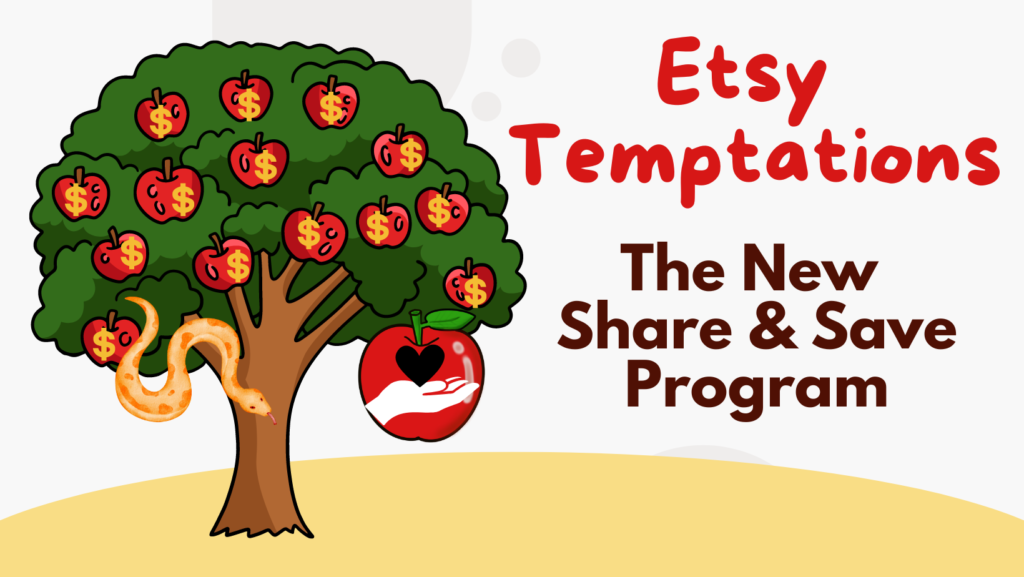Etsy apparently needs our help. They are clearly having difficulty attracting and retaining new customers, which is why they implemented their new Etsy Share & Save Program. It could be that they’ve lost their best customers – the ones who love to shop unique handmade items – because they are refusing to police their marketplace and remove all the resellers and trademark violators that are making them so much money right now.
Just like the offsite ads program, Etsy is passing part of their marketing burden off to the sellers, while also improving their numbers in time for the next quarterly report. And like any proper marketer they are making the program as tempting as possible to sellers.

Etsy Share & Save = Help Etsy
The newly launched Etsy Share & Save Program gives you unique trackable links to your shop or listings that you can share on your website or social media channels. If you make a sale from that link, Etsy will take 4% of the order total off your Etsy bill.
It sounds great, but for those of us who have been selling on Etsy for years, it’s a little more challenging to see anything positive in any of their new programs. Because we’ve experienced it all before and we’ve never seen anything that wasn’t 100% focused on serving Etsy’s needs only, all at the direct expense of their sellers’ needs.
So, after a deep dive into their terms & conditions for this program, these are the potential issues I can see:
1. Etsy can target your customers with offsite ads and you lose the 4% fee refund.
When a customer clicks your shared ink you can get a 4% fee refund if they buy something from your store within 30 days. BUT once that link is clicked, Etsy can easily track that customer and re-target them with an offsite ad from your store. If that customer clicks on the offsite ad link and purchases from your store during that 30 days, you don’t get the 4% back – even though it was your link that brought them to your store initially.

2. A customer can click on your link but end up buying from someone else’s store.
Etsy works very hard to get people off your store to continue searching in other stores. They provide more opportunities than other marketplaces for shoppers to search for items from your competitors. There is a high likelihood that customers will end up making purchases in another store. Etsy is also highly motivated to encourage this, because then they don’t have to pay a 4% fee to anyone.
3. If this was truly a seller benefit, the Etsy Share & Save program would be giving us 4% if our link generates a sale on anyone’s store not just our own.
Offering 4% on only our own stores is very low-risk, high-reward for Etsy as they can increase their traffic with little effort and little cost. They know that they can avoid the 4% refund if buyers start wandering and purchase at another store, or if they can capture that sale with an offsite ad, they can actually increase their fees.
4. It doesn’t make any sense to drive loyal customers to your Etsy store if you have your own website.
The only way the Etsy Share & Save program would have any value (and less risk to the seller) would be if you have a strong very loyal customer base that you know would buy from your store (and not wander off searching elsewhere). But if you do have those loyal customers, why would you want to direct them to Etsy instead of your own website – where you have more control over marketing, pricing, shipping, etc., with fewer fees?

5. By using the Etsy Share & Save program you will open up your website and social media channels to potential audits from Etsy.
If they see content that does not comply with their terms and conditions, then your Etsy store can be suspended. Their terms and conditions don’t mention being put on reserves, but I’m going to assume that that option is always on the table for everything. Noncompliance may not be a problem for everyone BUT if those audits are completed by bots, who knows what can happen. It’s obvious that their bots are not programmed well and are prone to mistakenly shutting down shops or taking down listings. I understand that Etsy wants to protect itself but auditing someone’s website and social media channels seems very invasive and really odd when they aren’t even auditing their own website.

6. Apparently Etsy won’t take responsibility for any issues you may have with the Share & Save Program.
This is a little confusing – who exactly would be responsible if not Etsy? This sounds like they know that their program will have glitches and that it’s likely that there will be problems in their tabulations for refunds. And we know that glitches are not likely to get fixed in a timely manner, if at all.

READ THE FULL TERMS & CONDITIONS HERE
For a full list of Etsy shenanigans check out our post: The Trouble With Etsy
SIDE NOTE: Gurus & Consultants
Be wary of gurus and consultants who always give overly positive information and views about Etsy. Their livelihoods are directly tied to Etsy and many of them are not likely going to objectively evaluate Etsy and any of it’s new programs. Here is one of the good ones that I subscribe to… Check out this YouTube channel: Etsy Consultant – Selling Redefined

